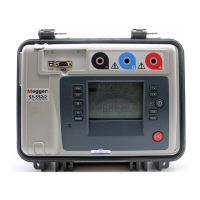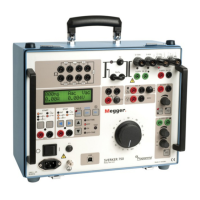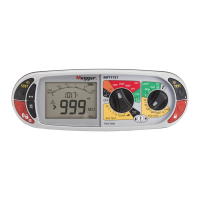Polarisation Index (PI) = R
10 min
R
1 min
The ‘Dielectric Absorption Ratio’ is the term applied to the polarisation
index using other time intervals set by T1 and T2.
If timers T1 and T2 are both set, then the insulation resistance measured
at these times is also recorded. These are displayed together with the
calculated dielectric absorption ratio under the T1, T2, and DAR segments
respectively.
The instrument can be made to display either the insulation resistances,
insulation currents or ratios plus capacitance measurements by using the
Ω/I toggle button. See section ‘Ω/I button’ for cycling through results and
toggling units.
Dielectric Absorption Ratio (DAR) = R
T2 min
R
T1 min
Dielectric discharge ‘DD’ test
The ‘DD’ test is a diagnostic insulation test that allows ageing,
deterioration, and voids in the insulation to be assessed. The result is
dependent on the discharge characteristic, so the internal condition of the
insulation is tested, largely independent of any surface contamination. On
discharge the capacitive component of the discharge current decays from
a high value with a relatively short time constant of a few seconds. The
other current component, comprising the released absorption current,
decays from a lower value with a relatively long time constant of up to
several minutes. If this component of the discharge current is large (>7 @
500 V test voltage) then the insulation condition is poor.
The main timer will default to 30 minutes, which is normally sufficient
time for full absorption to take place in an insulation material. The default
test voltage is set to 500 V. The ‘DD’ test requires the instrument to
measure the discharge current 1 minute after the removal of the test
voltage. At this time the capacitive current should be insignificant
compared with the released absorption current. On completion of the
test, the instrument uses this measurement along with the test voltage and
calculated capacitance to produce a figure of merit indicating the quality of
the insulation.
Dielectric Discharge (DD) = I
1 min
V x C
where I is the measured current expressed in milliamps (mA), V is the test
voltage in Volts (V), and C is the measured capacitance in Farads (F).
Measurements above 100 GΩ
Measurements up to 100 GΩ can be made without any special precautions,
assuming that the test leads are reasonably clean and dry. The guard lead
can be used to remove the effects of surface leakage if necessary. When
measuring resistances above 100 GΩ, the test leads should not be allowed
to touch each other, or any other object since this will introduce leakage
paths. Sharp points at the test lead connections should also be avoided
since this will encourage corona discharge.
The output is isolated, and so will float relative to ground such that the
positive terminal is at plus half of the test voltage, and the negative
terminal is at minus half of the test voltage with respect to ground.
Leakages therefore occur between the positive terminal and ground,
between the negative terminal and ground, and directly between the
positive and negative terminals. These leakages have a significant effect
17

